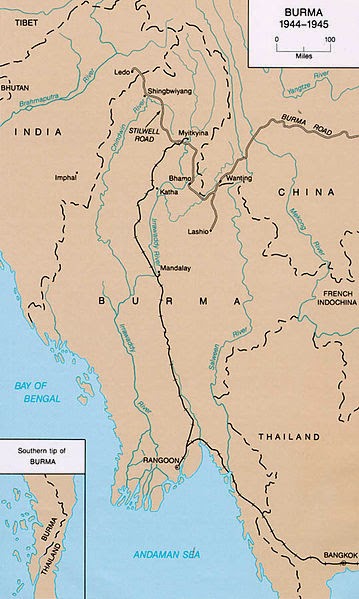In the summer of 1943, our EJZ was getting ready for induction into the Army, while Tadash Nagaki was dropping into Burma.
What sea route did Dr. Gumaer take with his mules in the fall of 1943? Port of embarkation was New Orleans. Going around Florida a German sub torpedoed them, but they made it to Newport News, Virgina, then crossed the Atlantic - with no convoy. Then what? Did they cross the North Atlantic, to Gibraltar, the Suez Canal, the Indian Ocean, around to Calcutta? Maybe they did; the victory at El Alamein had been in August 1942. Or did they go south, around the Cape of Good Hope?
The Burma Road had been built by the Chinese following the occupation of China by the Japanese prior to World War II. It ran from Lashio in Burma (Lashio could be supplied by rail from Rangoon) to Kunming in China.
The Japanese Imperial Army was eager to close off China's supply route, and so pressured the British to close the Burma Road.
From December 1941, the Japanese conquered Burma to loot its oil and rice for their army.
However, the "sleeping giant" had awakened; the Americans, with the Burma Road closed to the Allies, built an alternative road from Ledo, Assam, India ultimately to the Burma-China border, where it connected with the original Burma Road. This Ledo Road took two years to build: 1942-1944. Stillwell was in charge, and Donovan's OSS Detachment 101 and Merrill's Marauders fought the Japanese to make the roadbuilding and road-reopening possible.
In the meantime, the Allies supplied the Chinese, and flew their bombing runs, by air, using the Hump Route:
When the Ledo Road and the Burma Road were connected and secured and renamed the "Stillwell Road," troops and materiel went over them to China, on trucks (January 1945) and on mules.
But what of these mules, these tens of thousands of mules? Well, they were American, also.
And they had American veterinarians. The late Dr. Don Smith, bovine surgeon and Dean Emeritus at Cornell, pursued an interest in history of veterinary medicine. Dr. Smith had extensive conversations with a Dr. Kenneth Gumaer, who as a new graduate in 1943 was bored with meat inspection, got tangled up with OSS mules, and was no longer bored.
 |
| New grad Dr. Gumaer in 1943. Nice tie, Ken; the gents on this blog sport memorable neckwear; you fit right in. (© Cornell University) |
Veterinarians in Combat: The China-Burma-India Campaign was Dr. Smith's account of Dr. Gumaer's responsibility for his several hundred Army mules from Nebraska to Assam Province, thence over the Stillwell Road to the eventual May17th, 1944 capture of the Myitkyina all-weather airstrips by Merrill's Marauders. From Dr. Smith's post, which, sadly, is no longer available:
"Drs. Gumaer and Waple, each with their band of mules, became part of a long range penetration Special Forces unit that traversed the 6,000 foot Kuman Mountain range behind Japanese lines. 5
'In that kind of tight jungle warfare we were confined to the trails and getting out into the jungle was almost impossible. We were a real surprise to the enemy. I don’t think the Japanese expected our troops to be so experienced. Our troops killed a lot of the enemy soldiers that were not used to frontal assault—they’d just walk right into the fire. We had Japanese interpreters with us who were very loyal to our group and they got us a lot of good Information that made is easier for us to know what to expect.'"
 |
| The National WWII Museum in New Orleans has this photo of Hiram Boone, on Chick, in Burma. Nothing to do with Dr. Gumaer or Eugene Zdrojewski except for the US Army mules. |
What sea route did Dr. Gumaer take with his mules in the fall of 1943? Port of embarkation was New Orleans. Going around Florida a German sub torpedoed them, but they made it to Newport News, Virgina, then crossed the Atlantic - with no convoy. Then what? Did they cross the North Atlantic, to Gibraltar, the Suez Canal, the Indian Ocean, around to Calcutta? Maybe they did; the victory at El Alamein had been in August 1942. Or did they go south, around the Cape of Good Hope?
After a look at another Toyon Bay training grad, and his trip to Burma a little later than Dr. Gumaer's, we shall resume our account of the travels of our EJZ.


2 comments:
“Doc” Gumaer was my grandfather
Hello - that's great! Do you have any photos you would like to show us, or more stories to tell about your grandfather? You can put them up as comments, or you can send them to me at julie.zdrojewski@gmail.com - they can be a separate post.
Post a Comment